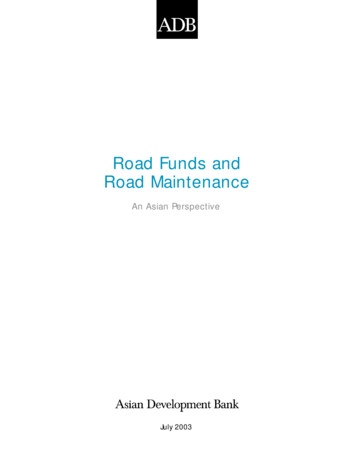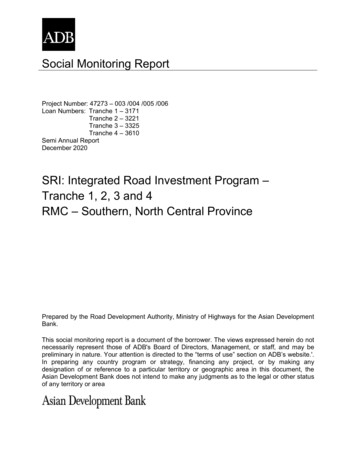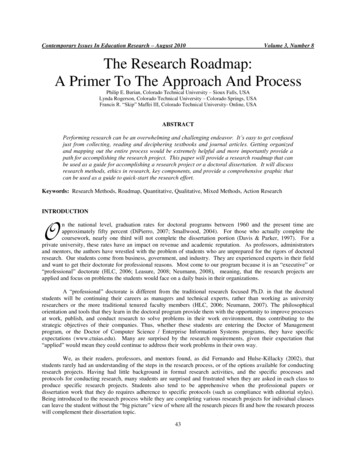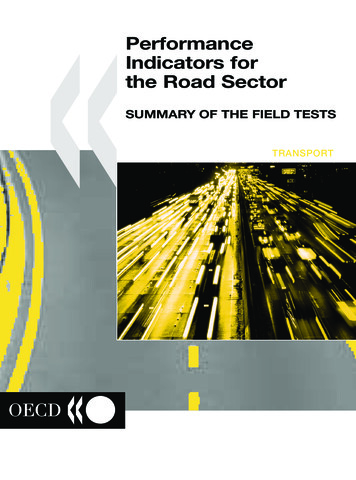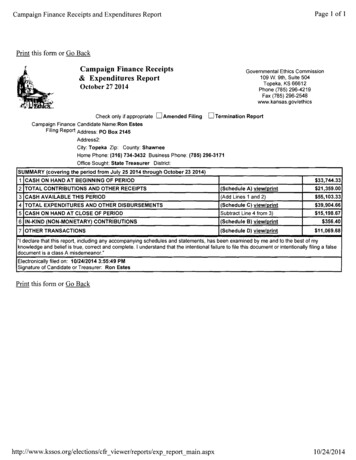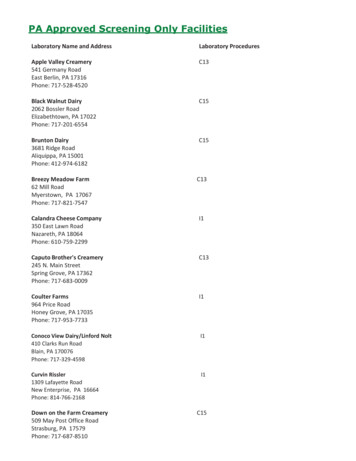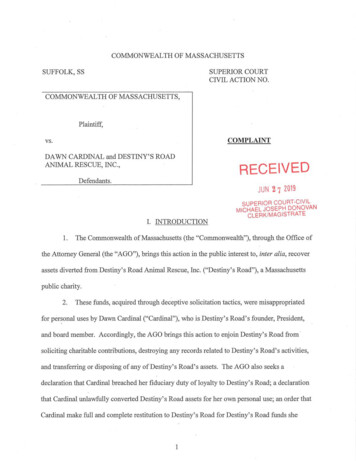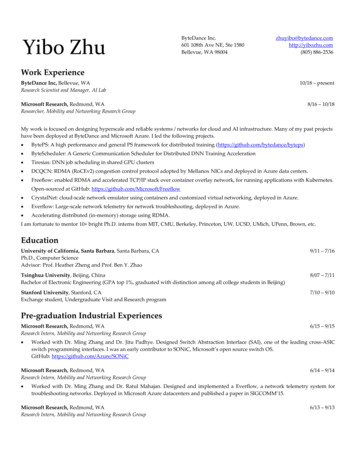
Transcription
Research-t he Road toMetal Detecting SuccessBy Roger Horrom EmailThis presentation will provide insight into what is necessary when doing research.It will provide guidelines and ideas for you to use to be a successful researcher.Treasure is not easy to find. By definition it is scarce. Treasure is typicallycompact, portable, and easy to convert to money. You must learn to search for thepleasure of the search. Research takes effort, but it can become exciting. It will notalways be easy and can take quite a bit of time. The more thorough your research,the more productive your metal detecting will become and the quality of yourfinds will improve. When you have success, don’t exhibit the results-the IRS maywant their share or more. Remember: treasures don’t become smaller in the telling.Be smart-be quiet.Select Here:2/26/2021Download this PresentationAuthor: Roger HorromFormatted by Metal Detecting Hobby Talkhttp://www.mdhtalk.org1
Research-t he Roadto Metal Detecting SuccessDEFINITION OF “RESEARCH” ACCORDING TO MERRIAM-WEBSTER DICTIONARY: RESEARCH-“the studious and critical inquiry and examination aimedat the discovery and interpretation of new knowledge” RESEARCH IS THE BACKBONE OF ALL TREASURE HUNTING ANDHISTORICAL INVESTIGATION. RESEARCH IS THAT DILIGENT SEARCH.Slide Narrative: According to Merriam-Webster Dictionary:Research- “the studious and critical inquiry and examination aimed at the discovery andinterpretation of new knowledge”Research is the backbone of all treasure hunting and historical investigation. While youcan find things when detecting, and maybe even be somewhat successful, research willhelp to make you more successful.You must be “diligent” while doing research. Be on the lookout for important details,misleading information, and discern “fact” from “fiction”.2/26/2021Author: Roger Horrom2
Research-t he Roadto Metal Detecting SuccessWHY DO RESEARCH DEVELOP A TREASURE LEAD IMPROVE RESULTS-OLDER / BETTER FINDS ELIMINATE BAD LEADS / “FOUND TREASURES”Slide Narrative: You should do research to develop a lead-without a good lead, your pathto success may end abruptly. A good lead will most likely lead to older and better finds.Weed out the bad leads, dead ends, lies, and already found treasures. These all cost youtime and effort and almost always are non-productive. Do early field trips to potentialsites to determine if the site is possible to hunt-if not, don’t waste time doing furtherresearch.2/26/2021Author: Roger Horrom3
Research-t he Roadto Metal Detecting SuccessTYPES OF RESEARCH GENERAL Global Search-Minimal Detail Formulate Many Leads Good Idea / Plan Generator SPECIFIC Start With a Single Lead Concentrate on a Single Subject Record All DetailsSlide Narrative: Start a global research where you look at everything. Don’t go into alot of detail yet. Begin to formulate leads. From this effort, develop plans and ideason how to proceed further. Formulate a lot of leads and then create a good idea andgenerate a plan.Specific research continues with a good single lead. Concentrate on that lead or asingle subject. Take notes and develop/record details. If it appears to be a really goodlead, DO IT NOW, be the first there. Don’t miss and opportunity due toprocrastination.2/26/2021Author: Roger Horrom4
Research-t he Roadto Metal Detecting SuccessTHE BIG SIXWHOWHEREWHYWHENWHATHOW LONGSlide Narrative: This chart refers to the six main questions one must ask and answer to helpthem develop a good lead.Who? Who occupied or used the location you have identified as a potential hunt site?Why? Why were they there? Did they reside there? Why did the event happen?What? What was the reason they were there? Just traveling through? Was there a watersource? Were there secure surroundings and was it easy to defend? Good food source?Where? Where is this location? Is it defined on a map? Is it still accessible and suitable fordetecting?When? When was the site occupied? Was it a long time ago or fairly recently? Was it occupiedfrequently?How Long? How long was the duration of the event? Was it multiple events of varyingduration?If you can develop good answers to the big six questions, then you have a potentially goodlead.2/26/2021Author: Roger Horrom5
Research-t he Roadto Metal Detecting SuccessHOW TO GET STARTED DECIDE WHAT YOU WANT TO FIND Coins, Artifacts, Caches, Jewelry, Gold RESEARCH WILL TAKE TIME, DEDICATION, PATIENCE Plan on Spending “Research Time” Learn to keep Good Records Throw in Supposition and Imagination HOW FAR ARE YOU WILLING TO TRAVELSlide Narrative: Decide if you want to find artifacts, coins, caches, jewelry, or gold. Gather tools, notes,information cards, maps, binders of your details, and other pertinent materials.Research will take time, patience, and dedication to do a good job and produce good results. Learn to keepgood records in written form. Don’t try to rely on your memory. Learn to imagine about the big six. Throw insupposition and imagination to form a picture in your mind as to what happened in the past. Think about traveldistance and cost of gas, food, and lodging to help you decide if the effort will produce results worth theexpense to accomplish your goals.2/26/2021Author: Roger Horrom6
Research-t he Roadto Metal Detecting SuccessBEGINNING YOUR RESEARCH LOCATE INFORMATION SOURCES Local and Other LibrariesHistorical SocietyMetal Detecting ClubCity, County, State Records CentersSenior Citizen ResidencesMap SourcesInternet AccessSlide Narrative: Locate information sources such as libraries, historical societies, metaldetecting clubs, city, county, and state records centers, senior citizen residences, mapsources, and internet sources. Consider joining a metal detecting club, a historical society,or volunteering at a senior citizens’ center. All of these sources will become invaluable tofind information to help develop good leads and learn about local history, events, and longforgotten activity sites.2/26/2021Author: Roger Horrom7
Research-t he Roadto Metal Detecting SuccessDEFINING POTENTIAL SITES VARY BY SIZE, AVAILABILITY, PRODUCTIVITY URBAN, RURAL, EXOTIC TEMPORARY OR FLEETING USED BY A FEW OVER A LONG TIME USED BY MANY OVER A SHORT TIME USED DURING A CERTAIN TIMESlide Narrative: Potential sites vary by size, availability, and productivity. They may belocated in an urban area, out in the country, or some exotic site such as in a foreign country.The site may be a temporary or fleeting site where the urgency of getting to it in a timelymanner before it is destroyed is a key to success. The site may be one that was used by afew people over a long time or one that was used by a lot of people over a short time. Bothof these could end up being productive. A site that was used during a certain time period,especially if it was used a long time ago could produce older and more interesting finds.2/26/2021Author: Roger Horrom8
Research-t he Roadto Metal Detecting SuccessSITES TO HUNTFORT SITESPLAYGROUNDSMILITARY INSTALLATIONSSCOUT CAMPSLOOKOUT / OVERLOOKATHLETIC FIELDSCHURCH SUPPER SITEPICNIC GROVESFISHING HOLES / CAMPSSWIMMING AREASRESORT AREASBEACH AREASOLD BARNSGHOST TOWNSWINTER SLEDDING HILLSCAMP GROUNDSOUTHOUSESRODEO ARENASSIDEWALK GRASS STRIPS BATTLE SITESBANDSHELLSREVIVAL SITESROADSIDE REST STOPS RACE TRACKSCOURTHOUSESAMUSEMENT PARKSCOLLEGE CAMPUSROADSIDE STANDSTELEPHONE BOOTHSRURAL MAILBOXESFLEA MARKETSREUNION AREASSKI LODGESDRIVE-IN THEATERSMOTELSVACANT LOTSTOWN SQUARESDISASTER SITESFRONT / BACK YARDSMINING CAMPSRAILROAD STATIONHUNTING LODGES / CAMPSHIKING TRAILSPARKING LOTSOLD GAS STATIONSCONSTRUCTION SITESHISTORICAL MARKERSOLD HOME SITESSlide Narrative: This chart provides a sizeable list of potential types of hunt sites, and most likely,you have some additional ideas of sites that could be added to the list. Highlight some of themduring your presentation. Mention that it is important to get proper permission to hunt most, if not allof these sites.2/26/2021Author: Roger Horrom9
Research-t he Roadto Metal Detecting SuccessRATING LEADS NO 100% CERTAIN LEADS PASS OR FAIL-3 PART TEST1. Name-Person or Family Name2. Location-Geographic Location Identified3. Dates-Basic Dates of Interest ANSWER “YES” TO ALL THREE TO CONTINUESlide Narrative: Remember-there are no 100% leads.Leads should be considered or not considered based on whether they pass or fail a threepart test.1. The lead most likely will have a name such as a person or family name, or maybe alocation name.2. If it is a location name it should have a geographic location identified.3. It should have a basic date of interest-something specific happened at a specific time.If the answer is “yes” to all three, then it is most likely valid to continue with the lead.2/26/2021Author: Roger Horrom10
Research-t he Roadto Metal Detecting SuccessSEARCHER’S MIND AND VIRTUES POSITIVE MENTAL ATTITUDE Healthy, Productive, More Receptive Ideas OPEN MINDEDNESS Must See the Facts the Way They are ACCURACY Verifiable, Reliable, Complete, Orderly Facts LOGIC Must Make SenseSlide Narrative: To be a successfulresearcher, you must maintain a positivemental attitude. Keep a healthy, open mind tobe productive and be receptive to ideas. Tokeep an open mind, you must see the factsthe way they are. Don’t try to change a factjust to make your ideas seem more feasible.Determine the accuracy of your information.Make sure you can verify it and that it isreliable, complete, and creates an orderlypicture of the truth. You can use yourimagination to develop possibilities, but thenverify if they are possible. Create “thoughtbooks” where you jot down your thoughtsand ideas such as while you are travelling inyour car, at work or home, and review themoften to help you develop additional newleads. Don’t create a fantasy. IMAGINATION To Locate, Find, and Verify-Not Create Fantasy2/26/2021Author: Roger Horrom11
Research-t he Roadto Metal Detecting SuccessFIVE RESEARCH PATHS READING DIRECT INQUIRIES MAPS OLD / NEW OBSERVATION AND AWARENESS INTERNETSlide Narrative: The five paths of research include reading, direct inquiries, use of old and newmaps, observation and awareness, and the internet. These are paths to follow, but you may not needto use all of them to develop a lead. Most of them will be helpful in some manner with most leadsthough.2/26/2021Author: Roger Horrom12
Research-t he Roadto Metal Detecting SuccessLIBRARY TYPES CITY COUNTY SMALL TOWN COLLEGE / UNIVERSITY HISTORICAL SOCIETY GENEOLOGY PRESERVATIONSlide Narrative: There are many types of libraries and each serve a special purpose. City libraries provide good localhistory information. County libraries are typically a larger scale with more historical documents over a larger area.Small town libraries are good for history, handwritten documents, rare publications, and locally published articlesand books. College libraries contain a large and more diverse collection, especially reference information such asencyclopedias. Historical society libraries have significant genealogy, local history, and knowledgeable people.Genealogy libraries have documents with people’s names, birth dates, dates of death, and marriages. Preservationlibraries have books and information on treasure examples and conserving of finds. Learn where these are and howto use them to your advantage.2/26/2021Author: Roger Horrom13
Research-t he Roadto Metal Detecting SuccessREADING HISTORY BOOKS OLD NEWSPAPERS LIBRARIES COMMUNITY CELEBRATION BOOKS SCHOOL YEARBOOKS MEMOIRS / DIARIESSlide Narrative: While in a library, types of material to read include history books,old newspapers, community celebration books, school yearbooks, and memoirs anddiaries. Many of these books are also available from other than libraries such asbookstores, flea markets, used book stores, and family and friends. Never pass upthe chance to add a book to your treasure hunting home library.2/26/2021Author: Roger Horrom14
Research-t he Roadto Metal Detecting SuccessLIBRARY RESEARCH A VALUABLE RESOURCE LEARN THE LOCAL SYSTEM Cataloging System / Items Computerized Information MEET THE LIBRARIAN / HISTORIAN Tell Them Your Needs / Goals Ask For Their Help LOCAL HISTORY IS IN REFERENCE SECTION Take a Notepad or Make CopiesSlide Narrative: A library is a valuable source. Take time to learn the local library system-card filerecords, computerized records, cataloging system, and possibly the older micro film/microfiche systems(these may no longer exist but if there, could be a source of older, more valuable information). Meet thelibrarian or historian at the library and let them know of your needs and goals. Ask for their help as theymay turn out to be a time saving method for quickly finding key information. Local history is usuallykept in the Reference Section of the library and, as a result, can only be used within the library. Plan totake a notepad or make copies of reference material.2/26/2021Author: Roger Horrom15
Research-t he Roadto Metal Detecting SuccessHOME LIBRARY CREATE YOUR OWN LIBRARY GATHER RESEARCH BOOKS / DOCUMENTS SUSCRIBE TO TREASURE MAGAZINES CREATE A FILE SYSTEM / MANILA FOLDERS HISTORICAL, TRAVEL MAGAZINES CIVIL WAR BOOKS COIN, ARTIFACT, COLLECTIBLES BOOKSSlide Narrative: Plan on creating your own home library. Gather your own set of research books and documents.Subscribe to treasure magazines and keep track of various treasure lead articles contained in them. Create a filesystem to help you keep track of your home library information as it will save time when trying to find things in itwhen you need it. Manila folders, a card file system, or entering information into a computer program may work foryou. Gather historical and travel magazines and clip articles from them for filing. If you are into Civil War artifacts,a collection of Civil War books, maps, and publications will be of great help when doing Civil War research. Coin,artifact, and collectibles books will be useful to help to identify, value, and describe your finds.2/26/2021Author: Roger Horrom16
Research-t he Roadto Metal Detecting SuccessNEWSPAPER RESEARCH BEST DAY-TO-DAY, YEAR-TO-YEAR SOURCE OLDER COPIES HAVE BEEN PRESERVED CHECK “ON THIS DATE” AND “LONG AGO” ON MICROFILM AT LIBRARIES LOOK FOR SUBTLE LEADS TAKE NOTES / MAKE COPIESSlide Narrative: Newspapers are the best day-to-day and year-to-year sources of information. Various types ofarticles such as lost and found, crimes, events, reunions, picnics, disasters, carnivals, and historical are key typesto look for. Many older copies have been preserved and are still available in various types of preservation filesystems-microfilm and microfiche, hard copies, and the newer digital versions. When researching newspapers,look for “on this date” or “long ago” types of articles. When reading these articles, look for subtle clues or leadssuch as: back in 1905 a picnic in Tower’s grove was attended by more than 100 citizens. Take handwritten notesor make copies of articles from newspapers for future reference.2/26/2021Author: Roger Horrom17
Research-t he Roadto Metal Detecting SuccessPHOTOGRAPHIC RESEARCH STUDY OLD PHOTOS CLOSELY LIBRARIES HAVE PHOTOGRAPH SECTIONS HISTORY BOOKS GATHER PICTURES OF THE ERA / AREA CLOTHING, BUILDINGS, JEWELRY STYLES USE A MAGNIFYING GLASS CONSTRUCTION DETAILS COMPARE OLD WITH RECENTSlide Narrative: If you have oldphotographs, be sure to study them closely.Some libraries have photograph sectionsavailable to look through. History booksoften contain good old photographs. Gatherand build a collection of pictures of acertain era or area. Study the clothing beingworn in the photos to determine the timeperiod. Check the buildings in the photosalso, and don’t forget to study the jewelrybeing worn as all these will help to date thephoto. You may need to use a magnifyingglass to see the details. Check theconstruction of buildings and compare oldphotos with newer photos to see changesmade over time. Shadows within photoshelp to tell the time of day and even thedirection of the objects in them. SHADOWS TELL TIME / DIRECTION2/26/2021Author: Roger Horrom18
Research-t he Roadto Metal Detecting SuccessOTHER PHOTOGRAPHIC RESEARCH AERIAL PHOTOS Shows Different Perspective INFRARED PHOTOS Shows Signs of Digging, Repair, Pathways TAKE YOUR OWN PHOTOS Date and Keep Notes Identify Location Shoot Different AnglesSlide Narrative: A good source depicting a different perspective of an area is aerial photos.They show building locations, terrain, and railways, and other key information that can proveto be valuable. Infrared photos while harder to obtain, can reveal signs of digging, repair andoften used pathways. Taking your own photos is a good way to record current condition of apotential site. Date and keep records of your photos so that you can identify the location, andshoot it from different angles as this may come in handy in the future.2/26/2021Author: Roger Horrom19
Research-t he Roadto Metal Detecting SuccessMUSEUM RESEARCH HISTORY MILITARY CITY ART SPECIALITY SMALL TOWNSlide Narrative: There are various types of museums that can be used for research includinghistory, military, city, art, specialty, and small town. Each of these offers a unique type ofinformation depending on what you are looking for and can be used accordingly.2/26/2021Author: Roger Horrom20
Research-t he Roadto Metal Detecting SuccessOTHER SOURCES BANKS Know the Leaders, Old Timers, Coins COURTHOUSE Land Records, Marriages, Deaths LAW ENFORCEMENT AGENCIES Old Crimes Information TOURIST BUREAUS Interesting Places to Visit HISTORICAL SOCIETY Consider JoiningSlide Narrative: Other sources that can be used todevelop treasure leads include banks where it is goodto know the bank officials as they can be good sourcesof community leaders’ names, who the old timers are,and information about coins. Courthouses containland, marriage, and death records which could beimportant. Law enforcement agencies might makeavailable old crimes information. Tourist Bureaus canprovide lists of interesting and historical places tovisit. Historical societies are worth considering joiningas they often have meetings to discuss historicallocations, have historical records, and areknowledgeable of the local history. Television oftenprovides shows on treasure hunting, historical sites,and educational topics. TELEVISION Treasure and Educational Shows2/26/2021Author: Roger Horrom21
Research-t he Roadto Metal Detecting SuccessOTHER SOURCES (Continue) METAL DETECTOR SHOPS Where Shops Are, Treasure Hunters Are ANTIQUE STORES Knowledge About Old Items COMPUTER Internet SearchSlide Narrative: Metal detector shops are a good place to visit as where the shops are, thetreasure hunters are. There are sure to be treasure tales told and experiences related that mayprovide a lead or two. Antique stores provide a source to see old items, some of which mayrepresent some of the treasures you have found. Your computer is an excellent source forresearch ideas and resource information with almost unlimited websites that provide excellentinformation that can be put to use in many ways to support your research efforts.2/26/2021Author: Roger Horrom22
Research-t he Roadto Metal Detecting SuccessCOMPUTER RESEARCH USE SEVERAL SEARCH ENGINES Google, Yahoo, etc. ENTER KEY WORDS / PHRASES VISIT METAL DETECTING CLUB WEBSITES VISIT TREASURE HUNTER’S FORUMS ENDLESS SOURCE OF GOOD LEADSSlide Narrative: There are many different search engines on the internet that can be used to find websites full of research information.Some of these are Google, Yahoo, and many others with new ones being added frequently. To perform searches, enter key words orphrases into the search engine address bar and you will be provided with an almost endless list of websites that provide informationabout the topic you entered. There are many metal detecting club websites that can be accessed that contain all forms of informationthat may lead to new potential hunt sites. The national organization website for the Federation of Metal Detector and ArcheologicalClubs. Inc. is www.fmdac.org and it contains information about clubs, metal detecting activities, manufacturer information, and linksto much information about metal detecting. There are many websites that include a treasure hunter’s forum where people interested inmetal detecting can carry on real-time conversations with others with the same interests and ask questions related to the hobby. Ingeneral, the internet, through using your computer, is an endless source of good leads for doing research.2/26/2021Author: Roger Horrom23
Research-t he Roadto Metal Detecting SuccessTREASURE HUNTING INTERNET WEBSITES MAP SITES: GOOGLE EARTH, BING MAPS, MAPQUEST 100’S OF LINKS TO ALL ASPECTS OF TREASURE HUNTING: www.treasurehuntersuniversity.com LINKS TO METAL DETECTING DISCUSSIONS: www.treasurenet.com www.abouttreasurehunting.com www.findmall.com FINDING NEW WEBSITES: Use Kay Words on any Browser Search BarMetal detecting, Treasure Hunting, etc.Slide Narrative: There are hundreds, if not more, of excellent metal detecting websites available on the internet.Map sites include Google Earth, Bing Maps, and Mapquest, all of which can be used as a source for findinglocations of potential hunt sites you have learned about and now need to see on an actual map. A good websitecontaining 100’s of links to sites covering all aspects of treasure hunting me of the links to metal detecting discussion websites are:www.treasurenet.com, www.abouttreasurehunting.com, www.findmall.comTo find new websites, which are created often, simply type key words or phrases into any search enginebrowser search bar.2/26/2021Author: Roger Horrom24
Research-t he Roadto Metal Detecting SuccessDIRECT INQUIRIES WHO TO TALK TO: kersSenior CitizensHistorical Societies QUESTIONS TO ASK: Where Events Took Place When Events Took PlaceSlide Narrative: Direct inquiries are a good source for treasure leads, but you must decidewho to talk to. Good sources include your relatives, your neighbors, your friends, coworkers, librarians, senior citizens, strangers and historical society members. Typicalquestions you might ask these people include where certain events took place and when didthese events take place.2/26/2021Author: Roger Horrom25
Research-t he Roadto Metal Detecting SuccessINTERVIEWS SENIOR CITIZENS: Grandparents Small Town “Spit and Whittle Bench” Nursing Home / Retirement Centers MAKE THEM COMFORTABLE / FEEL SAFE BE COURTEOUS / CONSIDERATE GET ACQUAINTED / SLOW CAUTIOUS APPROACHSlide Narrative: Senior citizens you should talk to are your grandparents, those individuals that you mightfind in a small town at the “spit and whittle bench”, and the residents of nursing homes or retirementcenters. When conducting your interviews always make the person you are talking to feel comfortable andsafe. Always be courteous and considerate and you will find that they enjoy visitors and a chance to talkwith someone. Don’t stay too long and be sure to follow the center’s rules on visiting. Be sure to checkwith the guardian of the individual if it is ok to talk with them. Get acquainted with the person, taking itslow and be cautious with them.2/26/2021Author: Roger Horrom26
Research-t he Roadto Metal Detecting SuccessQUESTIONS DON’T ASK “YES” OR “NO” QUESTIONS What Was It Like When You Were YoungWhere Did You Have FunWhat Was the Area LikeLove to Hear Old Lost Treasure StoriesDon’t Interrupt USE A NOTEBOOK / RECORDER USE A PHOTO ALBUMSlide Narrative: To get the best results, don’t ask “yes” or “no” questions. Instead, pose questions suchas: What was it like when you were young? Where did you go to have fun?; What was the area like backthen?; Do you have any old lost treasure stories?. Let them finish their answers and, by all means, do notinterrupt them. Use a notebook to keep a sort of record of their answers or, if it is ok with them, youmight use a tape recorder to get their responses. Ask them if they might have an old photo album, orbring one of your with you, and have them tell you about the photos included in the albums.2/26/2021Author: Roger Horrom27
Research-t he Roadto Metal Detecting SuccessOTHER PEOPLE HISTORIANS, FARMERS, LAWYERS PHOTOGRAPHERS, PILOT, BUSINESSMEN GAIN THEIR TRUST / RESPECT Talk History, Artifacts, Relics, Metal DetectorsAvoid the Term “Treasure”Let Your Subject Lead the WayDon’t InterruptSlide Narrative: Other individuals that are good sources to talk with are historians, farmers, and even lawyers aseach of these have their own stories to tell about old sites, stories about people, and historical events.Photographers, pilots, and businessmen also could lend some good information especially about site locations andimportant people and land owners. With each of these individuals you must work to gain their trust and respect.Talk to them about history, artifacts, relics, and your interest in metal detecting. Avoid using the term “treasure”in your discussions by using more generic terms such as lost items, artifacts, or even lost single coins. Let thesubject of the discussion lead the way as you can usually get them to start talking about topics that may lead totreasure leads without forcing the issue. And again, do not interrupt them while they are talking or that may leadto an early end of the discussion.2/26/2021Author: Roger Horrom28
Research-t he Roadto Metal Detecting SuccessMAPS OLD AND NEW COLLECT MAPS: From Library, Historical Society, Publishers Records Centers OBTAIN TOPOGRAPHICAL MAPS: Good Detail Shows Landmarks COMPARE OLD TO NEW MAPS: Look for Differences Use Same Scale Overlay MapsSlide Narrative: It is wise to create a good map collection from sources such as the library, historical societies, mappublishers, and records centers. Topographical maps are good maps to have as they show good detail and includemany of the landmarks of the area. The best way to use maps is to compare current maps to old maps and look for thedifferences in them such as where old home sites are shown on the old maps that no longer appear on the currentmaps. When comparing maps, try to make sure they are of the same scale so as to better understand the before andafter comparison and more exactly determine the correct location of a site. A handy way to compare maps is to makea transparency of the old map and overlay it on the new map so the differences are more apparent.2/26/2021Author: Roger Horrom29
Research-t he Roadto Metal Detecting SuccessOBSERVATION AND AWARENESS STUDY YOUR SURROUNDINGS LOOK FOR CLUES: Open FieldsClusters of TreesAbandoned / Derelict HomesOld Foundations / ChimneysDefining Road Signs / Place NamesRead Everything You CanHigh PointsSlide Narrative: When out on a potential hunt site, be sure to study your surroundings and observe any differencesfrom what your research may have exposed. Look for clues such as clusters of trees out in open fields as thesemight represent the location of a long lost home site. Look for abandoned or derelict homes or buildings, oldfoundations, and stand-alone chimneys, all signs of past human occupation and activity. Observe defining roadsigns and place names such as Clark’s Ferry Road or Harper’s Grove as these types of names often lead to actualsites where certain activities took place such as a ferry operation or picnics. Look for high points in fields andforests as these were often desired when people built house or settlements as they provided a safer, dryer, andmore secure site to live.2/26/2021Author: Roger Horrom30
Research-t he Roadto Metal Detecting SuccessRESEARCH CAUTIONS MUCH HISTORY HAS BEEN ‘INVENTED” Easier to Write it than Prove itValidate a Lead With a Second ReferenceUse Census, Tax, Grave RecordsValidate Geographical DirectionsGeography Changes-Oxbow Lakes were Rivers NOT EVERYONE TELLS THE TRUTH NOT ALL HIDDEN TREASURES STILL EXISTSlide Narrative: Remember that much history has been “invented”. It has been said that is it easier to write historythan it is to prove it as being accurate. Always validate a lead you have with a second reference. The use of census,tax, and grave records is a good way to confirm certain information you have discovered. Use maps and othermethods to validate geographical directions to be sure you are exactly where you need to be to search for yourtreasure. Remember that geography changes over time with such things as the formation of “oxbow lakes” thatwere once rivers. A very key point to remember when doing research is that not everyone tells the truth. It is up toyou to find the facts of your lead and confirm that what you have been told is true. A final thought to keep in mindis that not all hidden treasures still exist.2/26/2021Author: Roger Horrom31
Research-t he Roadto Metal Detecting SuccessRESEARCH SUMMARY RESEARCH IS ESSENTIAL TIME, DEDICATION, PATIENCE, IMAGINATIONSOLID WORK ETHICSFOLLOW-UP ON GOOD LEADSDISCARD BAD OR FALSE LEADSTAKE YOUR KNOWLEDGE TO THE FIELD APPLY YOUR FINDINGS AND SUCCESS WILL FOLLOW!Slide Narrative: To summarize the basics of doing research it is important to know:Research is essential if you are to improve your quantity and quality of metal detecting finds.It takes much time, dedication, patience, and imagination to do successful research.You need to have and follow a solid work ethic to produce good research results.You must always follow-up on all good leads.You must always discard bad or false leads to avoid wasting time on a dead-end search.Be sure to take your knowledge to the field and use what you have found out about the location toensure you get good results.If you do all this and apply your fin
to Metal Detecting Success Slide Narrative: While in a library, types of material to read include history books, old newspapers, community celebration books, school yearbooks, and memoirs and diaries. Many of these books
